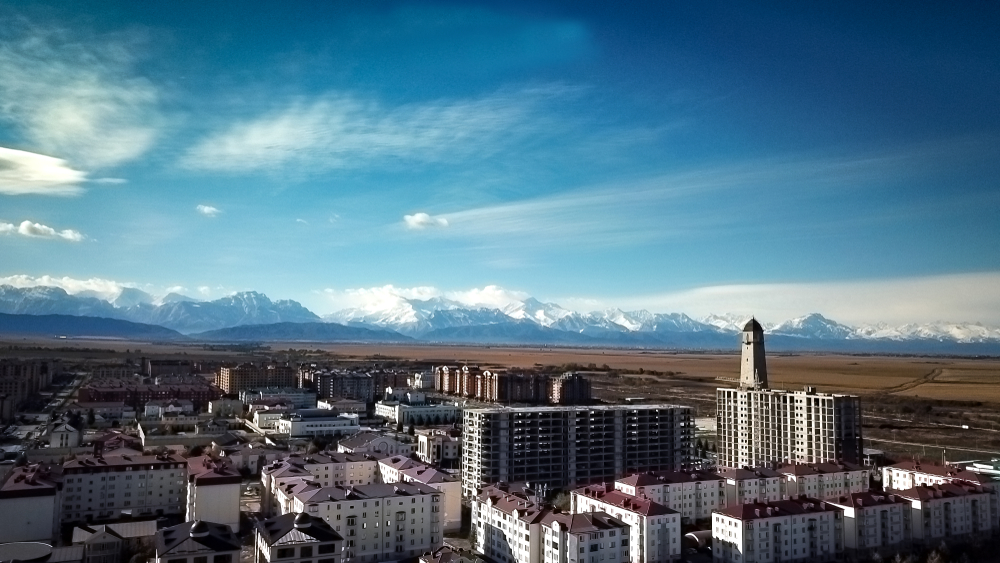Ingushetia fears outbreaks of violence
The small republic of Ingushetia lives in a tinderbox. There are serious concerns in the region that tensions related to contested border issues and potential unification with neighbouring Chechnya may escalate and lead to violence

Inguscezia-rischio-di-nuove-violenze
Magas, Ingushetia (Tangiev Rustam/Shutterstock)
A new wave of unrest in the republic started on March 26th, just two days before the Ingush parliament was supposed to approve amendments to the Referendum law, which would have limited the scope of legislation changes requiring a referendum. Crucially, the question on the republic’s borders would no longer require a referendum, which caused widespread dissatisfaction. Thousands of people gathered in the capital Magas and demanded to cancel the amendments.
In autumn 2018 these issues had already sparked protests against the very quick, not very transparent “exchange” of lands between Chechnya and Ingushetia. According to that deal, Ingushetia’s territory was reduced by 25,000 hectares – with quite a significant impact for the small republic of 3,000 square kilometres.
The amended Referendum law not only de facto confirmed the territory exchange, but also laid the ground for resuming the question of the republic’s unification with Chechnya. This scenario has been secretly considered for some time by the political establishments in Chechnya, Ingushetia, and Moscow. “First, they officially confirmed the transfer of our territories to North Ossetia, now to Chechnya. The republic is getting smaller and smaller. Eventually, they will say that it is not reasonable to have such a small republic at all and will merge it with Chechnya, arguing that it used to be like this and that other nations also live in joint republics”, said one of the protesters in Magas, asking to remain anonymous.
The past is not forgotten
Indeed, the Chechen and Ingush peoples used to share territory and power during the Soviet times and even before. The first time, both nations were officially united under one administrative region after the Caucasian war in 1862. Then, after several administrative reforms, the Bolsheviks founded the Chechen-Ingush Autonomous Soviet Socialist Republic in 1936. The republic was abolished in 1944 and restored again in 1957, when the Ingush and Chechen people returned from the exile in Siberia and Central Asia, where the Communists deported them under a false accusation of collaboration with the Nazi regime.
Eventually, the republic ceased to exist together with the Soviet Union in 1991. Since then, the Chechen and Ingush peoples have lived in their own national territorial units. Both nations had a good reason for this separation. The Chechens wanted to build their independent state, whereas the Ingush hoped to get back their lands, which were endowed to North Ossetia after the Chechen and Ingush deportation of 1944. The only way to do so was through staying with Russia.
The question of the reunification of the two republics was raised again in 2006, when Russia firmly put its foot in Chechnya. This time, the initiative came from the speaker of the Chechen parliament Dukvakha Abdurakhmanov. His idea was to merge Dagestan, Chechnya, and Ingushetia into one region, in line with Moscow’s new policy of regional enlargement. The idea, however, was supported neither by the federal centre nor by the local authorities. The armed conflict in Chechnya had already spilled over the borders and such a reform would have further facilitated the spread of the conflict across the North Caucasus.
A slightly different scenario…
The rumours about reunification appeared again in 2018, together with the protests in Magas against the transfer of lands to Chechnya, which followed the demarcation of the border between the two republics. Despite the official denials of the regional leaders, protesters suspect that the authorities are lying to them. They see confirmations to their suspicions in everything. “Otherwise, why would they start removing check-points in between the republics? Why would they constantly lie? The border has not been demarcated yet, but the Chechen authorities were already building infrastructures there", stated a participant of the protests in Magas. "Even the fact that this time they used power to disperse people is also very telling. There was absolutely no reason to do anything against a peaceful and well-organised protest…”, he added.
The use of force by the authorities and the determination to continue doing so have produced other fears. “We are on the edge of something very bad. It will be a slightly different scenario than in Chechnya in 1990s, but the idea is the same. People in Russia are becoming poor, the country is in crisis. What the Kremlin needs now is to distract the population’s attention. It is for this reason that they want (to create) instability somewhere. They have always done so…” affirms another protester.
Whether the suspicions expressed by the inhabitants of the republic are correct might become clear soon. Meanwhile, another round of peaceful protests is expected, whereas the authorities are getting ready to tackle a probable riot. The military troops are placed near the borders. The armed patrol vehicles regularly rumble through Ingush settlements. Some of the activists and protest organisers have been taken into custody and their location is kept in secret – repressive measures that are unusual for the republic. Those policemen who sided with the protesters in March lost their posts…
Apparently, the Ingush president – former Russian military officer Yunus-bek Yevkurov – does not intend to be too lenient anymore and his determination increases the chances for the civil unrest and further escalation of the conflict.
Historical background
1862 – Formation of the Terek district that includes Chechen and Ingush lands (under Emperor Alexander II)
1920-1921 – The Terek District is restructured by the Soviet authorities. The new Mountain Autonomous Soviet Socialist Republic (ASSR) includes the territories of today’s Chechnya, Ingushetia, North Ossetia, Kabardino-Balkarian, and Karachai-Circassia
1922 – The Chechen autonomous region is singled out from the Mountain ASSR
1924 – The Soviet authorities create the Ingush autonomous region
1934 – Unification of the Ingush and Chechen autonomous regions
1936 – The Chechen-Ingush Autonomous Soviet Socialist Region becomes an autonomous republic
1944 – The Chechen-Ingush Autonomous Soviet Socialist Republic is abolished. Chechens and Ingush are deported to Central Asia
1957 – The Chechen-Ingush Autonomous Soviet Socialist Republic is restored with different borders
1991 – Chechnya declares independence. Ingushetia votes for remaining in the RSFSR
1992 – Ingushetia is officially declared a republic within the Russian Federation
Featured articles
- Take part in the survey
Ingushetia fears outbreaks of violence
The small republic of Ingushetia lives in a tinderbox. There are serious concerns in the region that tensions related to contested border issues and potential unification with neighbouring Chechnya may escalate and lead to violence

Inguscezia-rischio-di-nuove-violenze
Magas, Ingushetia (Tangiev Rustam/Shutterstock)
A new wave of unrest in the republic started on March 26th, just two days before the Ingush parliament was supposed to approve amendments to the Referendum law, which would have limited the scope of legislation changes requiring a referendum. Crucially, the question on the republic’s borders would no longer require a referendum, which caused widespread dissatisfaction. Thousands of people gathered in the capital Magas and demanded to cancel the amendments.
In autumn 2018 these issues had already sparked protests against the very quick, not very transparent “exchange” of lands between Chechnya and Ingushetia. According to that deal, Ingushetia’s territory was reduced by 25,000 hectares – with quite a significant impact for the small republic of 3,000 square kilometres.
The amended Referendum law not only de facto confirmed the territory exchange, but also laid the ground for resuming the question of the republic’s unification with Chechnya. This scenario has been secretly considered for some time by the political establishments in Chechnya, Ingushetia, and Moscow. “First, they officially confirmed the transfer of our territories to North Ossetia, now to Chechnya. The republic is getting smaller and smaller. Eventually, they will say that it is not reasonable to have such a small republic at all and will merge it with Chechnya, arguing that it used to be like this and that other nations also live in joint republics”, said one of the protesters in Magas, asking to remain anonymous.
The past is not forgotten
Indeed, the Chechen and Ingush peoples used to share territory and power during the Soviet times and even before. The first time, both nations were officially united under one administrative region after the Caucasian war in 1862. Then, after several administrative reforms, the Bolsheviks founded the Chechen-Ingush Autonomous Soviet Socialist Republic in 1936. The republic was abolished in 1944 and restored again in 1957, when the Ingush and Chechen people returned from the exile in Siberia and Central Asia, where the Communists deported them under a false accusation of collaboration with the Nazi regime.
Eventually, the republic ceased to exist together with the Soviet Union in 1991. Since then, the Chechen and Ingush peoples have lived in their own national territorial units. Both nations had a good reason for this separation. The Chechens wanted to build their independent state, whereas the Ingush hoped to get back their lands, which were endowed to North Ossetia after the Chechen and Ingush deportation of 1944. The only way to do so was through staying with Russia.
The question of the reunification of the two republics was raised again in 2006, when Russia firmly put its foot in Chechnya. This time, the initiative came from the speaker of the Chechen parliament Dukvakha Abdurakhmanov. His idea was to merge Dagestan, Chechnya, and Ingushetia into one region, in line with Moscow’s new policy of regional enlargement. The idea, however, was supported neither by the federal centre nor by the local authorities. The armed conflict in Chechnya had already spilled over the borders and such a reform would have further facilitated the spread of the conflict across the North Caucasus.
A slightly different scenario…
The rumours about reunification appeared again in 2018, together with the protests in Magas against the transfer of lands to Chechnya, which followed the demarcation of the border between the two republics. Despite the official denials of the regional leaders, protesters suspect that the authorities are lying to them. They see confirmations to their suspicions in everything. “Otherwise, why would they start removing check-points in between the republics? Why would they constantly lie? The border has not been demarcated yet, but the Chechen authorities were already building infrastructures there", stated a participant of the protests in Magas. "Even the fact that this time they used power to disperse people is also very telling. There was absolutely no reason to do anything against a peaceful and well-organised protest…”, he added.
The use of force by the authorities and the determination to continue doing so have produced other fears. “We are on the edge of something very bad. It will be a slightly different scenario than in Chechnya in 1990s, but the idea is the same. People in Russia are becoming poor, the country is in crisis. What the Kremlin needs now is to distract the population’s attention. It is for this reason that they want (to create) instability somewhere. They have always done so…” affirms another protester.
Whether the suspicions expressed by the inhabitants of the republic are correct might become clear soon. Meanwhile, another round of peaceful protests is expected, whereas the authorities are getting ready to tackle a probable riot. The military troops are placed near the borders. The armed patrol vehicles regularly rumble through Ingush settlements. Some of the activists and protest organisers have been taken into custody and their location is kept in secret – repressive measures that are unusual for the republic. Those policemen who sided with the protesters in March lost their posts…
Apparently, the Ingush president – former Russian military officer Yunus-bek Yevkurov – does not intend to be too lenient anymore and his determination increases the chances for the civil unrest and further escalation of the conflict.
Historical background
1862 – Formation of the Terek district that includes Chechen and Ingush lands (under Emperor Alexander II)
1920-1921 – The Terek District is restructured by the Soviet authorities. The new Mountain Autonomous Soviet Socialist Republic (ASSR) includes the territories of today’s Chechnya, Ingushetia, North Ossetia, Kabardino-Balkarian, and Karachai-Circassia
1922 – The Chechen autonomous region is singled out from the Mountain ASSR
1924 – The Soviet authorities create the Ingush autonomous region
1934 – Unification of the Ingush and Chechen autonomous regions
1936 – The Chechen-Ingush Autonomous Soviet Socialist Region becomes an autonomous republic
1944 – The Chechen-Ingush Autonomous Soviet Socialist Republic is abolished. Chechens and Ingush are deported to Central Asia
1957 – The Chechen-Ingush Autonomous Soviet Socialist Republic is restored with different borders
1991 – Chechnya declares independence. Ingushetia votes for remaining in the RSFSR
1992 – Ingushetia is officially declared a republic within the Russian Federation









